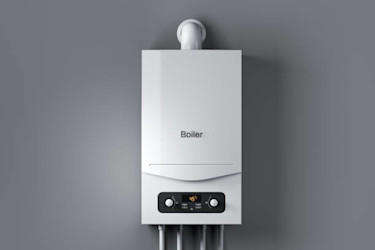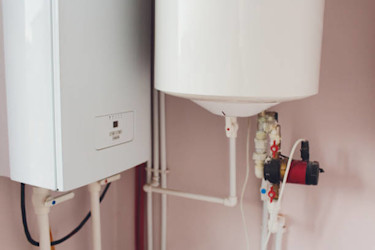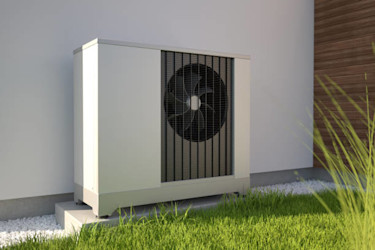Back Boiler Replacement Guide
If you still have a back boiler, you will be spending more money on your heating bills than you would if you had a newer, more efficient heating system. Updating your back boiler to a modern heating system might be costly at first, but in the long term, it could save you money. Continue reading to find out if it is worth replacing your back boiler.
Last updated - 25/10/2022
Estimated reading time - 6 minutes
What is a back boiler?
A back boiler is an appliance that uses the heat generated from a gas fire to heat the water that is to be used for a property’s hot water and central heating system.
Back boilers get their name from the fact that they are fitted to the back of a fireplace or stove. They were first launched in the 1960’s and gained popularity due to their compact size and the fact that they could be hidden out of sight behind a fireplace.
Today, back boilers are outdated and inefficient in comparison to modern heating systems. A new condensing boiler is typically between 90% and 94% efficient, whereas a typical back boiler is less than 70% efficient. To put this into money terms, for every £1 of fuel a 70% efficient back boiler burns, only 70p worth is used to heat up a home and the other 30p worth is wasted and expelled out of the chimney, whereas a 90% efficient boiler will only lose 10p worth of the fuel it burns to heat up a home.
Due to the inefficiency of old heating systems such as back boilers, in 2005 the Building Regulations made it compulsory for all new boiler replacements and installations to be high efficiency condensing boilers.
What is a condensing boiler?
A condensing boiler recovers heat from flue gases and recycles it back into the heating system to preheat the cold water entering the boiler. Instead of capturing heat from the gases in the flue, non-condensing boilers, like back boilers, expel it, which means this heat is wasted.
How does a back boiler work?
A back boiler is fitted behind a fireplace or stove and is connected to a hot water cylinder. Water from the mains is supplied to a cold water storage tank, which is usually located in the loft. The water is then heated by the back boiler and stored in the hot water cylinder. When needed, the hot water is circulated to the radiators and taps.
Should I replace my back boiler?
The simple answer is yes. There are many reasons why you should replace a back boiler with a modern boiler. Here are some of the main reasons why:
- Back boilers are a much less efficient way of heating a property. According to the Energy Saving Trust, replacing an old standard efficiency back boiler with a new modern boiler can reduce energy bills by over £300 while also reducing CO2 emissions.
- Although it is not illegal for a household to currently have a back boiler, since 2005 it has been illegal for them to be installed due to safety regulations and their high carbon emissions.
- Repairing and servicing a back boiler can be difficult and expensive due to a lack of availability of parts.
- There have been safety issues concerning back boilers, with many cases of back boiler related explosions.
What should I replace my back boiler with?
If you have an old back boiler and want to update it to a new high efficiency heating system, here are a few suitable options.
A combination boiler

Combi boilers are the most popular type of boiler in the UK. A combi boiler is a combination of a water heater and a central heating boiler in a single unit. Instead of heating and storing water in a hot water tank like a back boiler does, a combi boiler gets water from the mains water supply and heats it on demand.
The lack of a need for a tank or a cylinder makes a combi boiler a great choice for properties with limited space. Combi boilers are the perfect choice for small to medium sized homes with 1 bathroom.
A heat-only boiler
If you have a larger home with more than two bathrooms and high hot water demands, a heat-only boiler is a good option to replace your back boiler with.
A heat-only boiler, also known as a regular, conventional, traditional, or open-vent boiler, is a heating system that is made up of two tanks, a hot water cylinder and the boiler. Water from the mains is supplied to a cold water tank, which is often found in the loft, and is then fed to the hot water cylinder, where it is to be heated and stored for later use. The hot water is then supplied to taps and showers when needed. A pump circulates the hot water to radiators when the heating is turned on.
A system boiler

A system boiler works alongside a hot water cylinder to provide central heating and hot water to a property. System boilers heat water directly from the mains water supply to heat the radiators, and fills the hot water cylinder with hot water to be used for the taps and showers in a property.
Like a heat-only boiler, a system boiler also needs a hot water cylinder to operate. The major difference between a heat-only boiler and a system boiler is that system boilers do not need a cold water tank or a feed and expansion tank to operate. This means that system boilers take up less space than heat-only boilers while being able to deliver the same high volume of hot water to the property, making them a great choice for large homes with high hot water demands.
A low-carbon heating system

If you would like to replace your back boiler with the most environmentally friendly heating option, then a low-carbon heating system could be a perfect choice.
Low-carbon heating systems could reduce a household’s carbon emissions while also lowering energy bills due to how efficient they are. For example, a ground source heat pump could be between 300% and 500% efficient, which means it will produce 3 to 5 times more energy than it uses.
Three common low-carbon heating systems:
- Air source heat pumps - A heating system that converts thermal energy (heat) from the outside air into heat for your property.
- Biomass boilers - A heating system that uses natural/non-fossil fuel resources to create heat for use throughout your property.
- Ground source heat pumps - A heating system that extracts heat from the ground to heat your property.
Although a low-carbon heating system could provide savings on your energy bills, some are quite costly to purchase and install. For this reason, the government has introduced an initiative called the Boiler Upgrade Scheme. The Boiler Upgrade Scheme provides grants to homeowners to offset the initial upfront cost of installing a low-carbon heating system.
To find out more about low-carbon heating systems and if you are eligible for a grant of up to £6,000, click here.
Back boiler replacement costs
The initial cost of replacing a back boiler with a new heating system might be expensive, but it will save you hundreds of pounds each year on your heating bill.
The cost of replacing a back boiler depends on how much it will cost to remove the back boiler and how much the new heating system costs. If you already have a central heating system installed and would like to have your back boiler removed, getting rid of it and capping the pipework could cost around £500-£1,000.
Decommissioning a back boiler is a cheaper option than removing it. Decommissioning a back boiler means that it will be disconnected from the gas and power supply. Having your back boiler decommissioned instead of replacing it will save you money as it will avoid the need to open up a fireplace to access and remove the back boiler and the cost of reconstructing the fireplace after the back boiler’s removal.
The cost for a new combi, heat-only, or system boiler typically ranges between £500 and £2500 depending on the make and model of the boiler.
There are other factors that will need to be considered when replacing a back boiler, such as:
- What type/output of boiler do you need?
- Do you need to re-pipe the system to a new location?
- Does the hot water cylinder need to be removed or upgraded?
- If you have removed the back boiler, will you plaster over the hole in the wall, or install a new fireplace?
A Gas Safe Registered engineer will be able to advise you on what the best heating systems for your home and energy needs are.
Get a new boiler.
Has your boiler seen better days? With Smart Plan you can get a new boiler for as little as £30 a month, with a 10 year service plan included.

